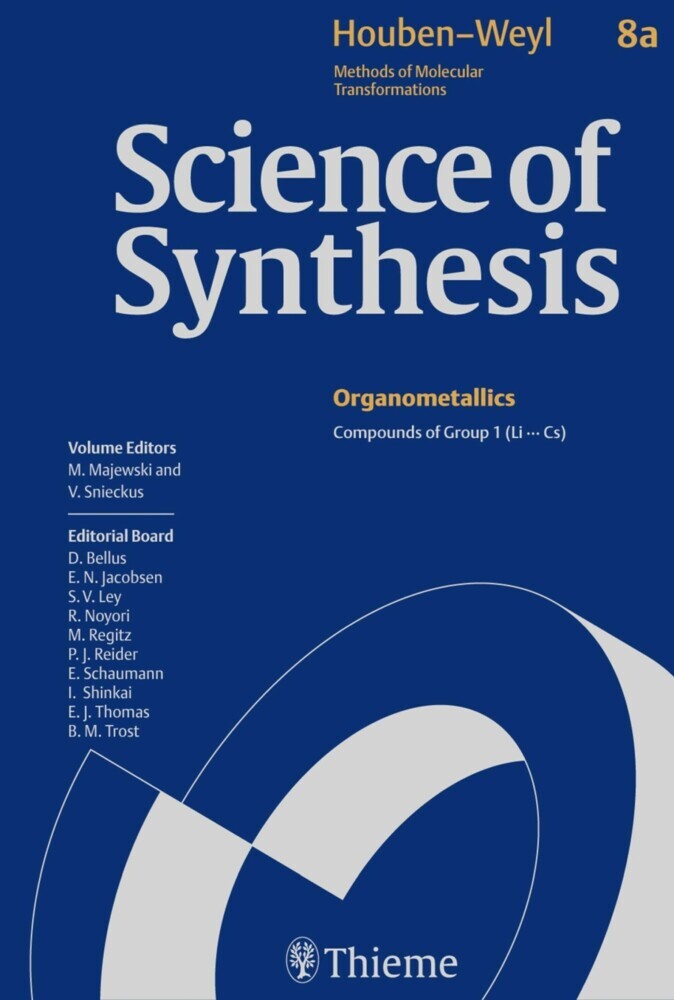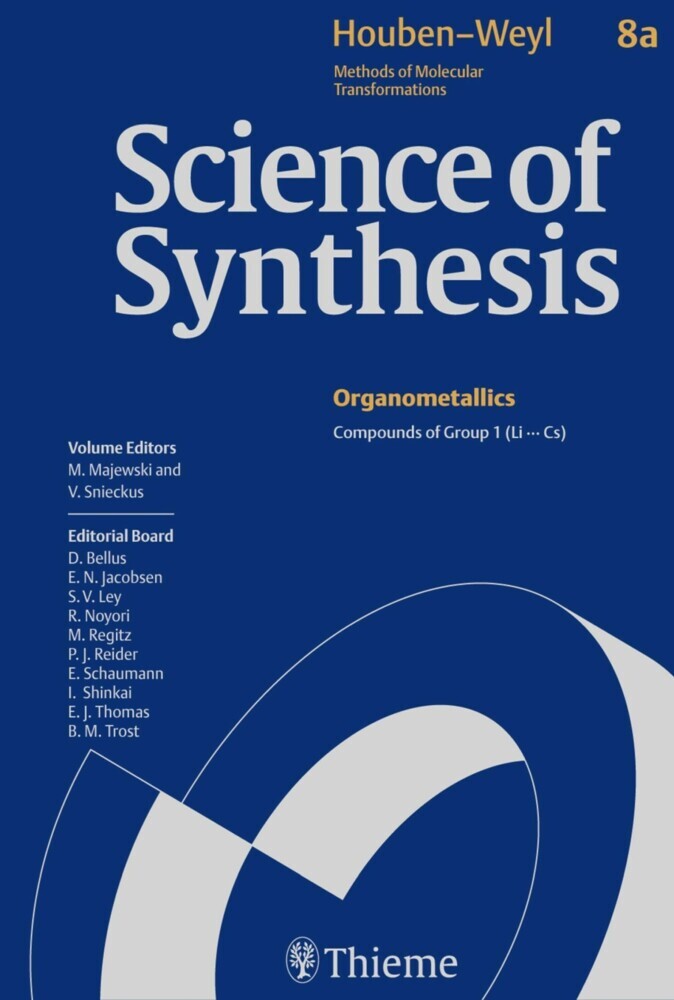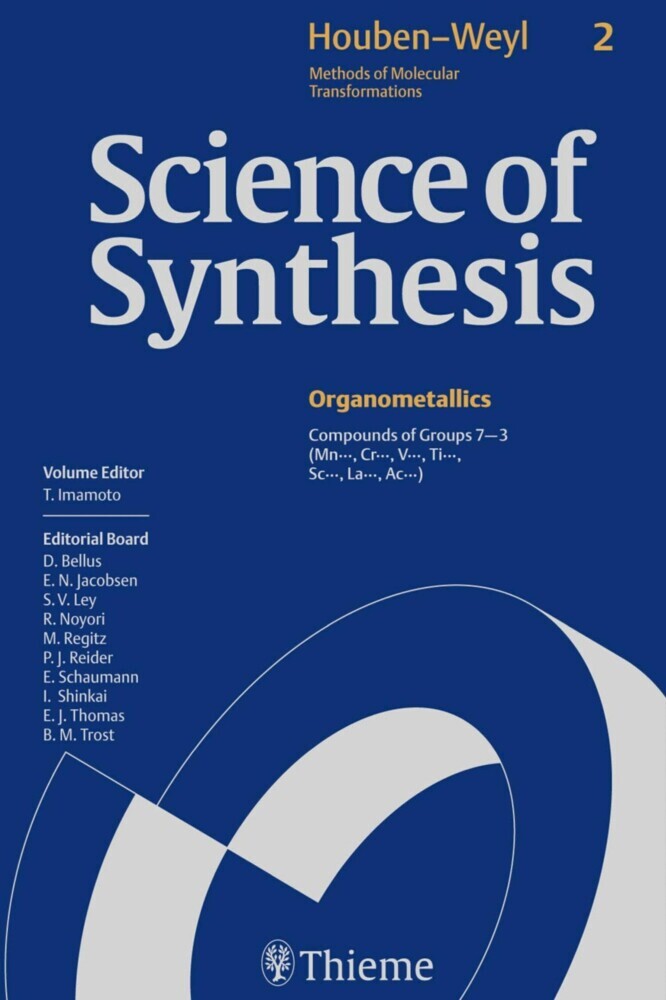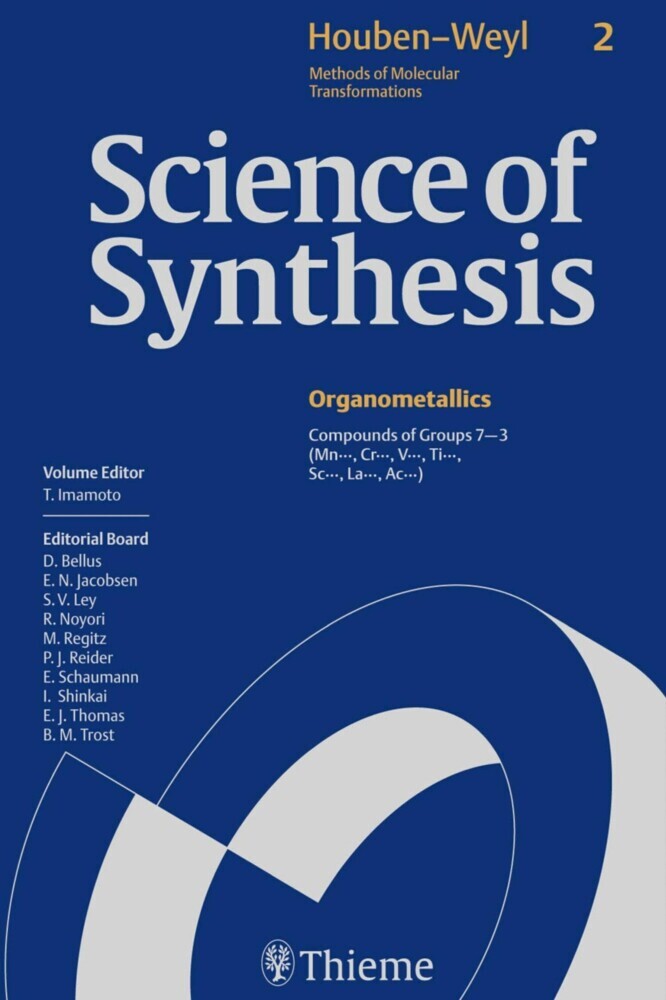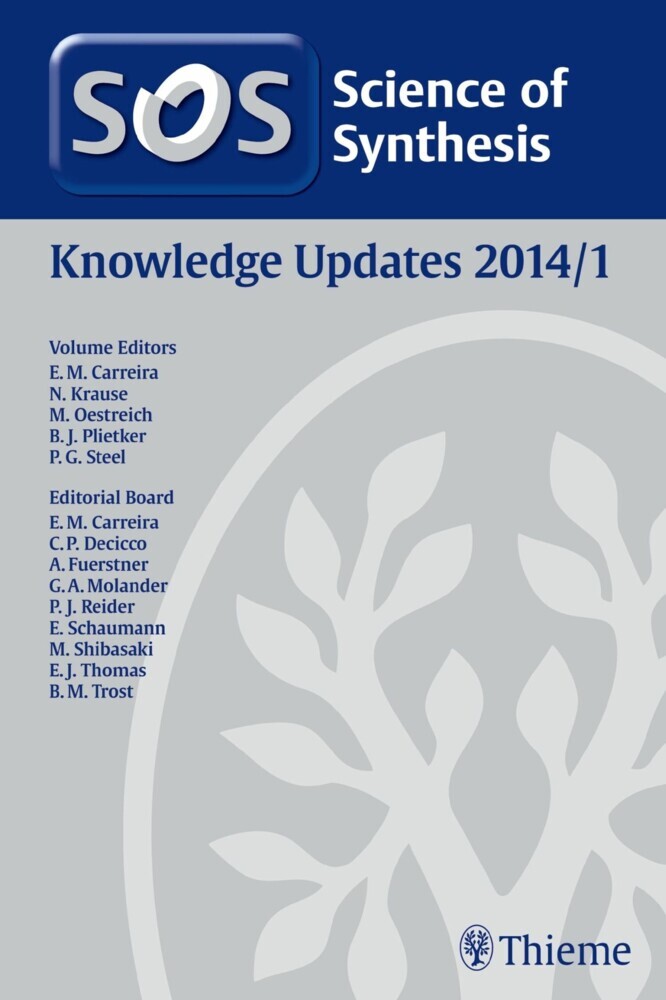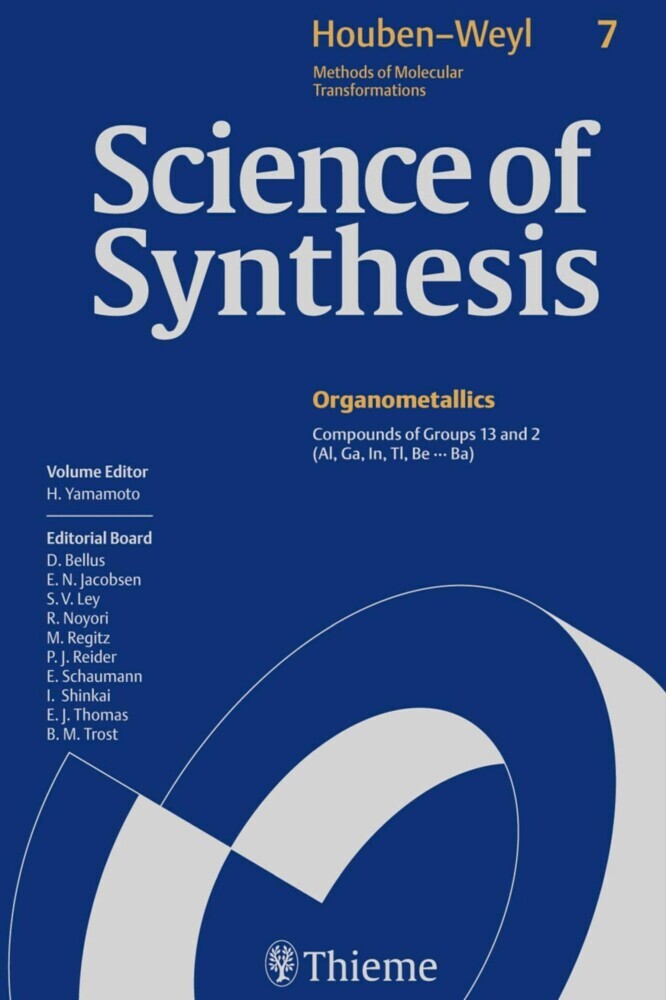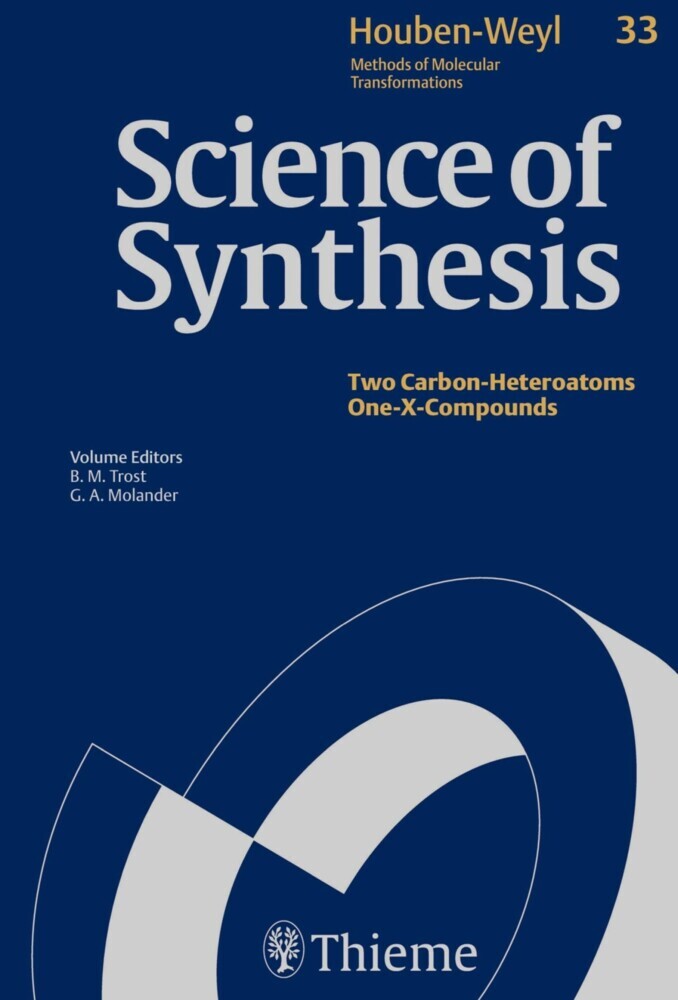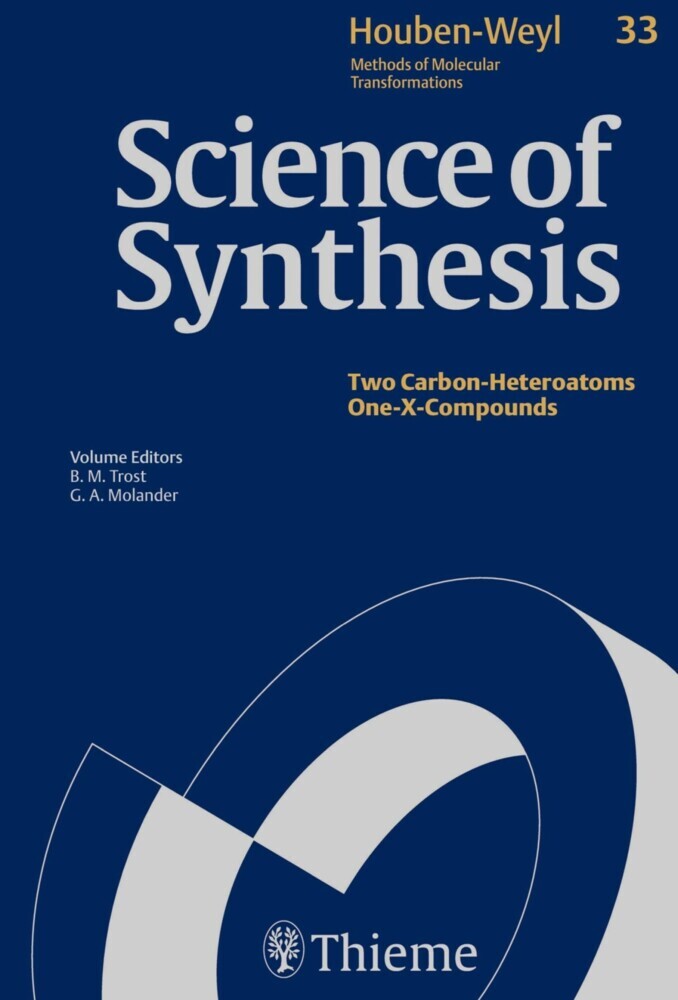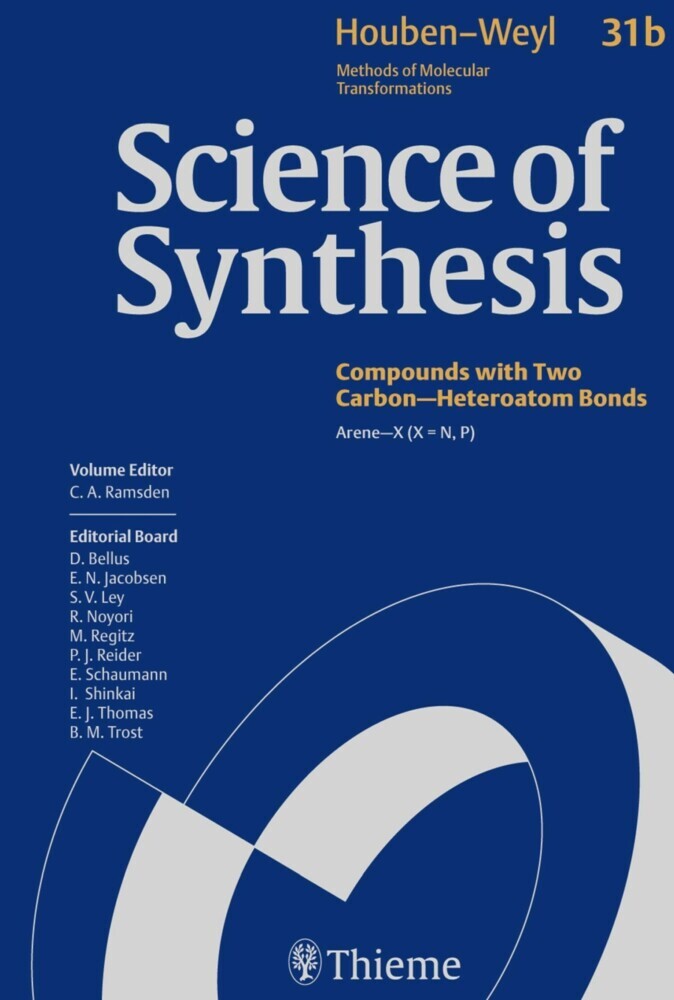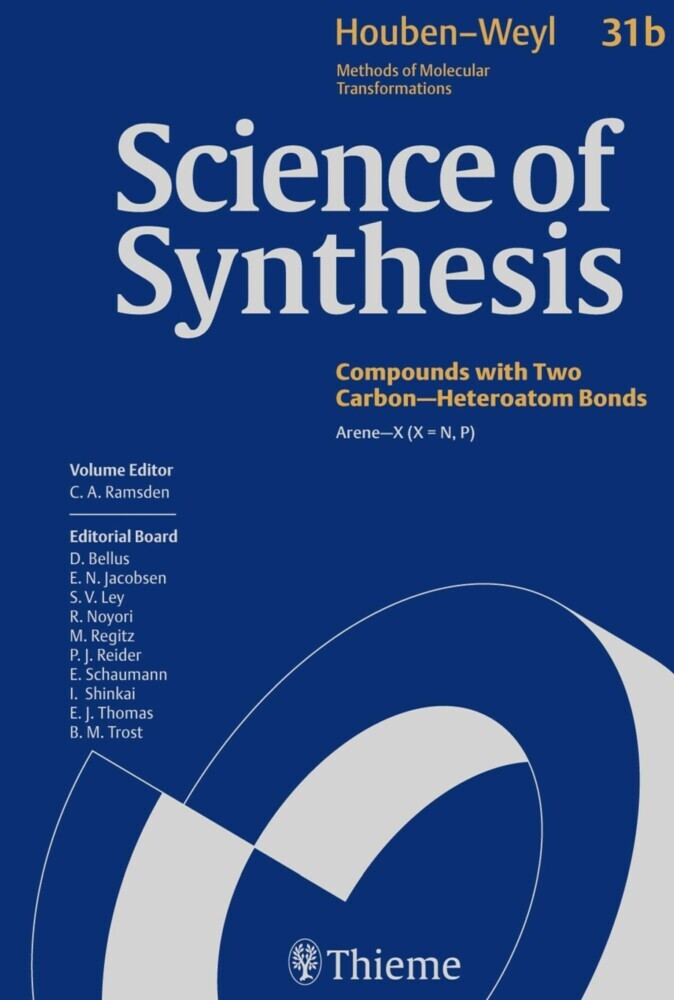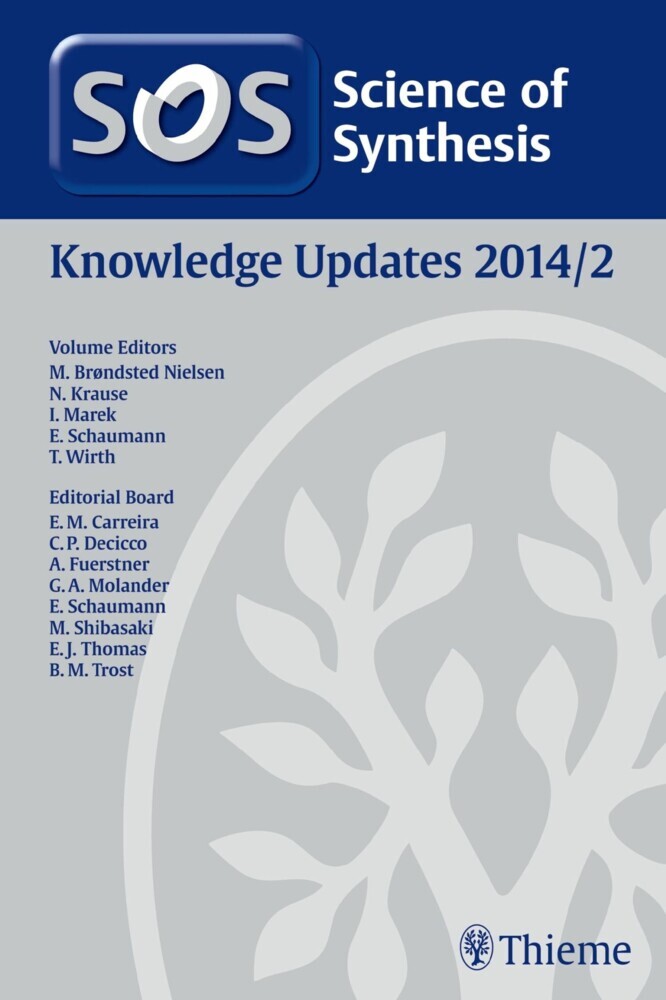Science of Synthesis: Houben-Weyl Methods of Molecular Transformations Vol. 8a
Compounds of Group 1 (Li...Cs)
Science of Synthesis: Houben-Weyl Methods of Molecular Transformations Vol. 8a
Compounds of Group 1 (Li...Cs)
Science of Synthesis: Houben-Weyl Methods of Molecular Transformations is the entirely new edition of the acclaimed reference series Houben-Weyl, the standard synthetic chemistry resource since 1909. This new edition is published in English and will comprise 48 volumes published between the years 2000 and 2008.
Science of Synthesis is a quality reference work developed by a highly esteemed editorial board to provide a comprehensive and critical selection of reliable organic and organometallic synthetic methods. This unique resource is designed to be the first point of reference when searching for a synthesis strategy.
- Contains the expertise of presently 400 leading chemists worldwide
- Critically evaluates the preparative applicability and significance of the synthetic methods
- Discusses relevant background information and provides detailed experimental procedures
For full information on the Science of Synthesis series, visit the Science of Synthesis Homepage
1;Science of Synthesis - Volume 8a: Compounds of Group 1 (Li...Cs);11.1;Title page;31.2;Imprint;51.3;Preface;61.4;Overview;121.5;Table of Contents;161.6;Introduction;361.7;8.1 Product Class 1: Lithium Compounds;401.7.1;8.1.1 Product Subclass 1: Lithium Metal;781.7.1.1;Applications of Product Subclass 1 in Organic Synthesis;791.7.1.1.1;8.1.1.1 Method 1: Synthesis of C--Li or Si--Li Groups and Their Reactions with Carbon Electrophiles;791.7.1.1.1.1;8.1.1.1.1 Variation 1: Reductive Halogen--Metal Exchange;791.7.1.1.1.2;8.1.1.1.2 Variation 2: Reductive Metalation of Carbon--Chalcogen and C--N Bonds;901.7.1.1.1.3;8.1.1.1.3 Variation 3: Reductive Metalation of Aryl C--H, Diarylmethylene C--H, Terminal Alkyne C--H, Vinyl C--H, C==C, and Strained C--C Bonds;1001.7.1.1.2;8.1.1.2 Method 2: Synthesis of the C--Li Bond Followed by Protonation, Coupling, or Elimination;1021.7.1.1.2.1;8.1.1.2.1 Variation 1: From Carbon--Heteroatom and Selected C--C Bonds;1021.7.1.1.2.2;8.1.1.2.2 Variation 2: Birch Reductions;1181.7.1.1.2.3;8.1.1.2.3 Variation 3: Heteroaromatic Birch Reductions;1311.7.1.1.2.4;8.1.1.2.4 Variation 4: Styrenes, 1,3-Dienes, and Alkynes;1361.7.1.1.3;8.1.1.3 Method 3: Synthesis of X--Li Bonds (X = O, N, S, P);1421.7.1.1.3.1;8.1.1.3.1 Variation 1: Reductive Metalation of Alcohols, Amines, Thiols, Phosphines, and X--X Bonds;1421.7.1.1.3.2;8.1.1.3.2 Variation 2: Reduction of C==O and C==N Bonds;1441.7.1.1.3.3;8.1.1.3.3 Variation 3: Reduction of p-, Strained C--C, or C--X Bonds a to a Carbonyl Group;1481.7.2;8.1.2 Product Subclass 2: Lithium Hydride;1681.7.2.1;Applications of Product Subclass 2 in Organic Synthesis;1681.7.2.1.1;8.1.2.1 Method 1: Reactions as a Base;1681.7.2.1.2;8.1.2.2 Method 2: Superactive Lithium Hydride;1691.7.2.1.3;8.1.2.3 Method 3: Other Lithium Hydride Activation Methods;1701.7.3;8.1.3 Product Subclass 3: Lithium Halides, Lithium Cyanide, and Related Salts;1741.7.3.1;Applications of Product Subclass 3 in Organic Synthesis;1741.7.3.1.1;8.1.3.1 Method 1: Organic Salt Solutions as Reaction Media;1741.7.3.1.2;8.1.3.2 Method 2: Effects on Main Group Organometallic Chemistry;1751.7.3.1.2.1;8.1.3.2.1 Variation 1: Salt Effects in Enolate and Similar Chemistry;1761.7.3.1.2.2;8.1.3.2.2 Variation 2: Protonation of Enolates;1791.7.3.1.2.3;8.1.3.2.3 Variation 3: Lithium Salt Effects in Grignard Chemistry;1801.7.3.1.3;8.1.3.3 Method 3: Effects on Transition-Metal Chemistry;1811.7.3.1.3.1;8.1.3.3.1 Variation 1: Palladium-Catalyzed Reactions;1821.7.3.1.3.2;8.1.3.3.2 Variation 2: Organocopper Reactions;1831.7.3.1.3.3;8.1.3.3.3 Variation 3: Reactions of Other Transition Metals;1841.7.3.1.4;8.1.3.4 Method 4: Addition Reactions;1841.7.3.1.4.1;8.1.3.4.1 Variation 1: Cycloaddition Reactions;1841.7.3.1.4.2;8.1.3.4.2 Variation 2: Addition to Carbonyl Compounds;1861.7.3.1.4.3;8.1.3.4.3 Variation 3: Miscellaneous Additions;1881.7.3.1.5;8.1.3.5 Method 5: Single-Bond Cleavage Reactions;1881.7.3.1.6;8.1.3.6 Method 6: Condensation Reactions;1911.7.3.1.7;8.1.3.7 Method 7: Elimination Reactions;1931.7.3.1.8;8.1.3.8 Method 8: Hydride Reductions;1931.7.3.1.9;8.1.3.9 Method 9: Lithium Salts as Sources for Halogens or Cyanide;1941.7.4;8.1.4 Product Subclass 4: Lithium--Oxygen Compounds;2001.7.4.1;Applications of Product Subclass 4 in Organic Synthesis;2001.7.4.1.1;8.1.4.1 Method 1: Reactions Using Lithium Hydroxide;2001.7.4.1.2;8.1.4.2 Method 2: Reactions Using Lithium Carbonate;2011.7.4.1.3;8.1.4.3 Method 3: Use of Lithium Hydroperoxide and Related Reagents;2011.7.4.1.4;8.1.4.4 Method 4: Reactions Using Lithium Acetate;2021.7.4.1.5;8.1.4.5 Method 5: Reactions Using Lithium Alkoxides;2031.7.4.1.5.1;8.1.4.5.1 Variation 1: Elimination and Condensation Reactions;2031.7.4.1.5.2;8.1.4.5.2 Variation 2: Oxidation Reactions with Copper(II) Bromide--Lithium tert-Butoxide;2041.7.5;8.1.5 Product Subclass 5: Lithium--Sulfur, --Selenium, and --Tellurium Comp
| ISBN | 9783131779717 |
|---|---|
| Article number | 9783131779717 |
| Media type | eBook - ePUB |
| Copyright year | 2014 |
| Publisher | Georg Thieme Verlag KG |
| Length | 987 pages |
| Language | English |
| Copy protection | Digital watermarking |

